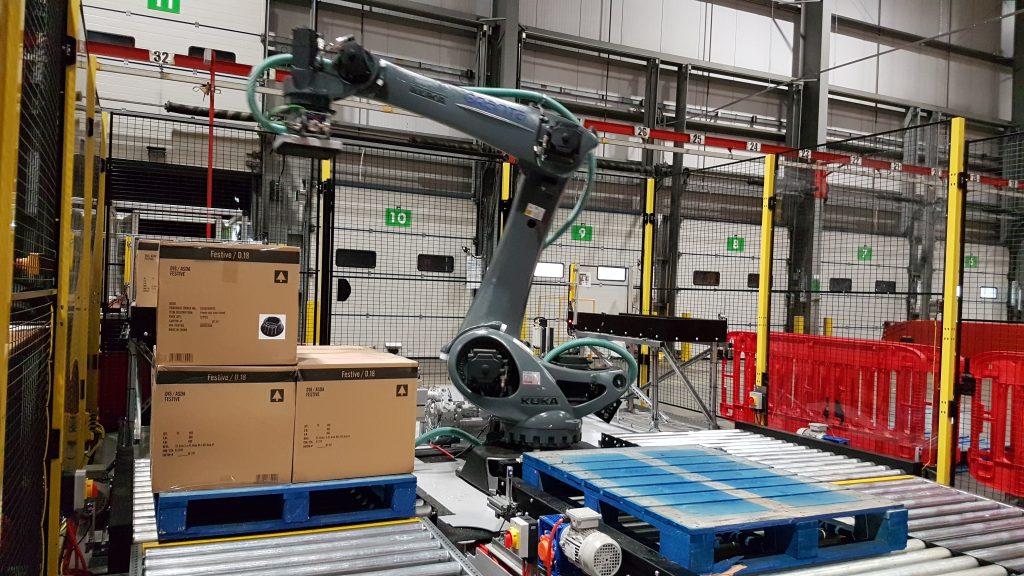Robotic palletisers are automated machines designed to stack and organise products onto pallets. While they offer many benefits, they may also come with potential problems and challenges. Here are some common problems associated with robotic palletisers, and the suggested solutions to overcome these problems.
- Programming Complexity
Problem: Setting up and programming a robotic palletiser can be complex and time-consuming. It requires expertise in robotics and automation, and any mistakes in the programming can lead to operational issues.Solution: Invest in user-friendly programming interfaces and easy-programming software that simplifies the robot programming and enables your factory staff to reprogram the robot for new products and stack patterns.
- Product Variability
Problem: Robotic palletisers may struggle with handling products of different shapes, sizes, and weights. They often require customization or additional tooling for various product types.Solution: Implement adaptive grippers and end-effectors that can handle a wide range of product sizes and shapes. Consider modular tooling that can be easily swapped for different products.
- Speed and Efficiency
Problem: While robots are generally efficient, they may not always be as fast as needed for high-volume production lines. Speed limitations can lead to production bottlenecks.Solution: Optimize the layout of your production line to ensure a smooth flow of products to the robotic palletiser. Consider upgrading to faster robots if necessary.
- Maintenance
Problem: Like any machinery, robotic palletisers require regular maintenance to ensure they operate smoothly. Unexpected breakdowns or downtime can be costly.Solution: Implement a proactive maintenance schedule with regular inspections and preventive maintenance tasks. Invest in high-quality components and robots with a reputation for reliability.
- Palletising Patterns
Problem: Achieving optimal palletising patterns for different products can be challenging. Ensuring stability and proper weight distribution on pallets is crucial to prevent damage during transport.Solution: Utilise advanced software algorithms that can automatically generate optimised palletising patterns. Palletiser with easy-programming software will have this included in the software and your factory staff will be able to re-program stack patterns in just minutes.
- Product Handling
Problem: Delicate or irregularly shaped products can be difficult to handle for robotic palletisers, potentially leading to product damage or misplacement.Solution: Invest in grippers and end-effectors with adjustable sensitivity and compliance to handle delicate products. Implement vision systems to improve product recognition and handling.
- Safety
Problem: Robots in the workplace require strict safety measures to prevent accidents and injuries. This includes safety fencing, emergency stop systems, and ongoing safety training for personnel.Solution: Ensure compliance with safety regulations, including proper safety fencing, emergency stop systems, and safety training for personnel. Regularly review and update safety procedures.
- Integration
Problem: Integrating a robotic palletiser into an existing production line can be complex, especially if the equipment and software are not compatible.Solution: Work closely with experienced system integrators to ensure seamless integration of the robotic palletiser into your production line. Choose equipment and software that are compatible with your existing systems.
- Cost
Problem: The initial investment for a robotic palletiser can be significant, and the return on investment (ROI) may take some time to realize. Smaller businesses with limited budgets may find it challenging to justify the expense.Solution: Calculate the long-term ROI to justify the initial investment, it is well worth looking at the cost savings relating to intangible benefits as well then investigating this. Explore financing options or consider leasing equipment to spread out the cost. Look for grants or incentives that may be available for automation investments.
- Software and Control Issues
Problem: Software glitches or control system malfunctions can lead to errors in palletising, causing delays and potentially damaging products.Solution: Keep software and control systems up to date with regular updates and maintenance. Invest in redundancy and fail-safe mechanisms to minimize the impact of software glitches.
- Maintenance Costs
Problem: Maintaining and servicing robotic palletisers can be expensive, especially if specialized technicians are required.Solution: Negotiate service contracts with the equipment manufacturer or a trusted service provider to control maintenance costs. Train in-house staff to perform routine maintenance tasks. Typically, a good robot palletiser system with an industrial robot will last for many years with minimal maintenance costs
- Environmental Conditions
Problem: Robots may be sensitive to environmental factors like dust, temperature fluctuations, or humidity, which can affect their performance.Solution: Create a controlled environment for the robotic palletiser if environmental factors are a concern. Use protective enclosures or clean rooms as needed.
- Operator Training
Problem: Employees responsible for overseeing and maintaining the robotic palletiser must receive adequate training. Lack of trained personnel can lead to inefficiencies and downtime.Solution: Invest in comprehensive training programs for operators and maintenance personnel. Ensure that your team is well-prepared to operate and troubleshoot the robotic palletiser.
- Product Changeovers
Problem: Switching between different product types can require reprogramming and adjustments, which can lead to downtime.Solution: Develop standardized changeover procedures and tools to minimize downtime during product transitions. Consider using quick-change tooling for flexibility.
Continuous monitoring, feedback, and improvement are essential to address these problems effectively. Regularly assess the performance of your robotic palletiser and make adjustments as needed to optimize its operation within your specific production environment.
As outlined above, whilst there are some problems that are associated with robotic palletisers, with good training, regular maintenance and a well-established integrator, these issues can be overcome or at least minimised.
If you would like to discuss your specific application in more detail, please contact us on 01223 499488 or helpline@granta-automation.co.uk.









Warning: Undefined variable $aria_req in /var/www/granta-automation.co.uk/news/wp-content/themes/twentyten/comments.php on line 81
Warning: Undefined variable $aria_req in /var/www/granta-automation.co.uk/news/wp-content/themes/twentyten/comments.php on line 86